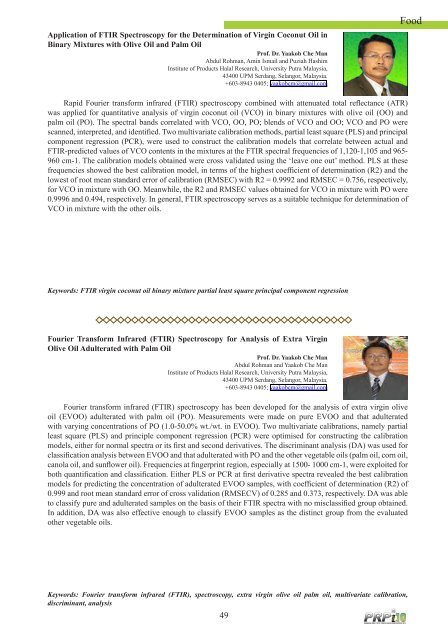BUKU ABSTRAK - Universiti Putra Malaysia
BUKU ABSTRAK - Universiti Putra Malaysia
BUKU ABSTRAK - Universiti Putra Malaysia
You also want an ePaper? Increase the reach of your titles
YUMPU automatically turns print PDFs into web optimized ePapers that Google loves.
Application of FTIR Spectroscopy for the Determination of Virgin Coconut Oil in<br />
Binary Mixtures with Olive Oil and Palm Oil<br />
Prof. Dr. Yaakob Che Man<br />
Abdul Rohman, Amin Ismail and Puziah Hashim<br />
Institute of Products Halal Research, University <strong>Putra</strong> <strong>Malaysia</strong>,<br />
43400 UPM Serdang, Selangor, <strong>Malaysia</strong>.<br />
+603-8943 0405; yaakobcm@gmail.com<br />
Rapid Fourier transform infrared (FTIR) spectroscopy combined with attenuated total reflectance (ATR)<br />
was applied for quantitative analysis of virgin coconut oil (VCO) in binary mixtures with olive oil (OO) and<br />
palm oil (PO). The spectral bands correlated with VCO, OO, PO; blends of VCO and OO; VCO and PO were<br />
scanned, interpreted, and identified. Two multivariate calibration methods, partial least square (PLS) and principal<br />
component regression (PCR), were used to construct the calibration models that correlate between actual and<br />
FTIR-predicted values of VCO contents in the mixtures at the FTIR spectral frequencies of 1,120-1,105 and 965-<br />
960 cm-1. The calibration models obtained were cross validated using the ‘leave one out’ method. PLS at these<br />
frequencies showed the best calibration model, in terms of the highest coefficient of determination (R2) and the<br />
lowest of root mean standard error of calibration (RMSEC) with R2 = 0.9992 and RMSEC = 0.756, respectively,<br />
for VCO in mixture with OO. Meanwhile, the R2 and RMSEC values obtained for VCO in mixture with PO were<br />
0.9996 and 0.494, respectively. In general, FTIR spectroscopy serves as a suitable technique for determination of<br />
VCO in mixture with the other oils.<br />
Keywords: FTIR virgin coconut oil binary mixture partial least square principal component regression<br />
Fourier Transform Infrared (FTIR) Spectroscopy for Analysis of Extra Virgin<br />
Olive Oil Adulterated with Palm Oil<br />
Prof. Dr. Yaakob Che Man<br />
Abdul Rohman and Yaakob Che Man<br />
Institute of Products Halal Research, University <strong>Putra</strong> <strong>Malaysia</strong>,<br />
43400 UPM Serdang, Selangor, <strong>Malaysia</strong>.<br />
+603-8943 0405; yaakobcm@gmail.com<br />
Fourier transform infrared (FTIR) spectroscopy has been developed for the analysis of extra virgin olive<br />
oil (EVOO) adulterated with palm oil (PO). Measurements were made on pure EVOO and that adulterated<br />
with varying concentrations of PO (1.0-50.0% wt./wt. in EVOO). Two multivariate calibrations, namely partial<br />
least square (PLS) and principle component regression (PCR) were optimised for constructing the calibration<br />
models, either for normal spectra or its first and second derivatives. The discriminant analysis (DA) was used for<br />
classification analysis between EVOO and that adulterated with PO and the other vegetable oils (palm oil, corn oil,<br />
canola oil, and sunflower oil). Frequencies at fingerprint region, especially at 1500- 1000 cm-1, were exploited for<br />
both quantification and classification. Either PLS or PCR at first derivative spectra revealed the best calibration<br />
models for predicting the concentration of adulterated EVOO samples, with coefficient of determination (R2) of<br />
0.999 and root mean standard error of cross validation (RMSECV) of 0.285 and 0.373, respectively. DA was able<br />
to classify pure and adulterated samples on the basis of their FTIR spectra with no misclassified group obtained.<br />
In addition, DA was also effective enough to classify EVOO samples as the distinct group from the evaluated<br />
other vegetable oils.<br />
Keywords: Fourier transform infrared (FTIR), spectroscopy, extra virgin olive oil palm oil, multivariate calibration,<br />
discriminant, analysis<br />
49<br />
Food



